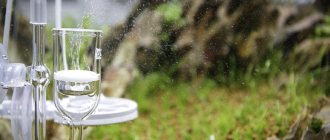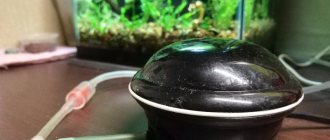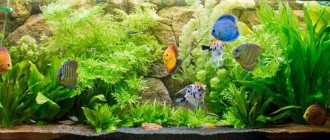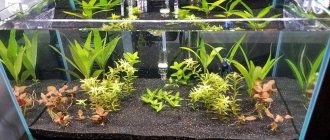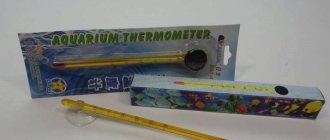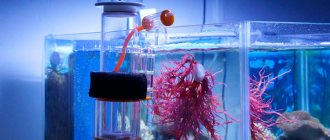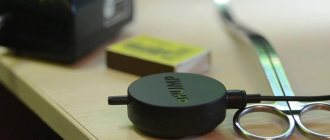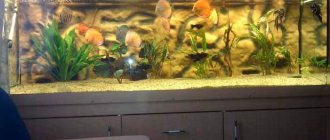A grotto is a natural or man-made cave of limited size. An aquarium grotto is a design element and a necessary shelter for many inhabitants.
- Fish, shrimp, and crabs that are active at night hide in shelters in the light.
- Small individuals look for a place protected from aggressive or predatory neighbors.
- Place for spawning: fish tend to eat eggs and fry.
- Many species of fish are individual, protecting their own territory. Ideally, each fish has a mink.
Many hobbyists consider the interior of an aquarium as a unique product. Therefore, they prefer to build grottoes for the aquarium with their own hands. The most popular of the stones.
DIY grotto
Treat natural materials for the grotto with caution. Do not mine in places with problematic ecology. Do not use stones with “rusty” colored veins. Exceeding the concentration of iron threatens algae thickets and fish poisoning.
Tree species that color the water (oak) are not suitable for an aquarium grotto. The wood should not be rotten: it spoils the water.
Rinse and boil aquarium decorations. There is a risk of infection with pathogenic bacteria and parasites.
Stone structures can be massive. To protect the glass, use weight-distributing stands and place the grotto closer to the aquarium fittings.
From stone
A common option: a shelter made of massive flat stones. If fish are prone to moving decorations or digging (catfish, botia), the elements are fixed with aquarium silicone glue. Plastic colorless sealants (Ceresit, Krass, Tytan, Chemlux) are preferred.
Each fish has a hole
It is known that different species of fish have different preferences for the places in which they are ready to settle. And it’s better to decide on this before making a grotto with your own hands.
Catfish need a wooden niche or at least a large piece of driftwood to hide under. Breeders advise taking branches or roots of linden, grape vines, pears, and apple trees. The branches should be wide enough and form something like a pool so that the adults freeze in it, and then the offspring will grow there. Also, crawling towards the trunk, the catfish collects particles that improve its digestion.
Viviparous fish, such as swordtails, guppies and mollies, need wide houses with small entrances. The female will calmly give birth in them and the fry will sit in them. Even parents can show aggression towards newborns. Excellent options would be coconut halves, a ship with a wide and hollow deck, or a cave.
Labyrinth fish, for example, lalius, bettas and gouramis, during the period of preparation for offspring, very aggressively attack anyone who approaches their bubble home. To separate families and neighbors, more than one grotto is placed in such an aquarium, and the shapes and sizes should be as varied as possible
But goldfish, which grow to quite large sizes, simply love to spin around in numerous holes and buildings. Flat castles with wide and varied arches or arches glued together from small stones are perfect for them.
It is important that when placing a grotto made by yourself or bought in a store in an aquarium, it is important to maintain the proportions, not allowing it to occupy more than 30 percent of the volume.
Properly and creatively selected decorations will decorate the aquarium and the interior as a whole.
Video about creating a grotto for an aquarium
AdminAuthor of the article
Did you like the article?
Share with your friends:
Errors
Errors in the manufacture of structures are usually associated with incorrect selection of materials and poor quality disinfection.
Limestones are used for grottoes in soft water aquariums with medium/low pH. The composition of the environment is dangerous for the inhabitants.
- Non-aquarium sealant was used to glue the structures together. Materials not intended for aquariums are dangerous due to the release of toxins.
- The elements have not been boiled or have not been washed properly. Risks infection and parasites.
- Detergents were used. Risks of fish poisoning.
Requirements
The material must not contain harmful impurities. For example, lime, inclusions of iron (nails, staples), chemical dyes, soluble elements, such as paper, fabric.
- If you select materials yourself, you must follow the preparation rules
- Fish are injured on sharp corners and surfaces, get stuck and die in narrow crevices.
- Wooden parts are cleaned and treated
- Varieties with oily wood, such as oak and pine, are not suitable.
Look what beauty you can make for your pets.
Clay crafts
If possible, you can make a grotto from red clay. This method is the most labor-intensive of all, because the clay must be fired, otherwise the product will simply break.
So, first you need to build a cave of a suitable shape. For example, in the form of a pot with a broken side or just a rectangular house. To make it spherical, you can use a balloon: inflate it to the desired size, cover it with a layer of clay (not too thin), let it dry and carefully deflate the ball, being careful not to crumple the edges of the clay sphere.
Then the product must be dried. This can be done in the sun or in the microwave. After this, firing is required. If there is a workshop with a muffle furnace nearby, then you can go there. If not, then you will have to use an oven preheated to 220 degrees. It is better to leave the door ajar. Firing takes about an hour, after which the temperature gradually decreases over 15-20 minutes . If you turn off the oven immediately, the clay will become brittle.
After firing, you can place the product next to the fish. If you decide to paint it, you need to make sure that the paints are non-toxic and will not poison the water. It is advisable to additionally burn purchased shards to kill microbes.
The clay grotto is the most labor-intensive of all, because the clay must be fired, otherwise the product will simply break.
Wooden buildings
The wood craft option is also not bad, but it is more complicated. First you need to select a small stump or driftwood without signs of rotting, clear the bark and drill holes in it for fish. One big one or many small ones - depends on the design. You can even drill out figured ones.
Then you need to sand the edges so that the fish does not harm itself . This should be done throughout the entire depth of the hole. Then burn the wood with a gas torch or blowtorch, so as not to set it on fire, you need to know how to do it correctly. To prevent the wooden grotto from starting to float at the slightest movement of water, it is glued to the base and sprinkled with soil.
What should an aquarium be like for a red-eared slider?
An aquarium for a red-eared turtle is a small ecosystem that you can create in your home with your own hands. When choosing the size and type of aquarium, it is necessary to take into account the size of the adult animal and the characteristics of its body. This is a swimming reptile, which, in addition to water, vitally needs land, where it will bask and receive an ultraviolet tan. The land area must be at least 25% of the terrarium area. It should be securely fastened, or better yet, glued to the base of an artificial pond, especially if there are several turtles.
The volume of water in the aquarium is one of the most important points that needs to be treated with special attention. Red-eared turtles move and swim mainly underwater, where they feel safe, sometimes spending a long time at the bottom
In addition, the smaller the volume of water, the faster it becomes polluted, as a result of which the terrarium loses its decorative effect, and the turtle may simply get sick. For young individuals up to 10 cm in size, 100 liters of water is sufficient. And taking into account land and air space, the volume of the terrarium should be approximately 150 liters. As the animal grows, the aquarium for the red-eared turtle will have to be replaced with a larger one. The more water there is in the reservoir, the longer it will remain clean and transparent, and the more comfortable the turtle will feel.
The arrangement of a piece of land also needs to be approached with due attention. When creating an island for the red-eared turtle, it is advisable to provide a convenient approach to it
The shore should not end abruptly; it is better if it is equipped with a ladder or a miniature ladder with a rough but non-scratching surface. It can also be a large stone or a grotto, the slopes of which gradually flatten towards the very bottom of the aquarium. There is an ultraviolet lamp above the land, under which the turtle will dry its shell, bask and sunbathe. If the optimal water temperature for the red-eared turtle is approximately 25-280C, then above land it should be a couple of degrees higher. The island should be located approximately 30 cm below the edge of the terrarium, otherwise the animal may get out and run away.
When designing an aquarium for a red-eared slider, you need to choose safe materials without sharp edges and corners that pose a potential danger to the health of the animal. The soil covering the bottom should not be too fine, since turtles sometimes swallow it, and, in addition, it becomes dirty faster and is difficult to clean. It is better to use pebbles with a fraction of 5-6 cm. Live plants should not be used in such terrariums, as turtles eat them very quickly. They try to chew artificial algae, but, realizing that it is inedible, they quickly lose interest in it. Therefore, in the underwater part, you can install plastic or silk plants with weights at the base so that turtles cannot tear them out of the ground. Artificial vines can also be placed in the above-water part. In addition, the terrarium can be decorated with various driftwood, grottoes, fancy stones and other elements that will make the pond more picturesque and natural.
The aquarium for the red-eared turtle must be kept clean, since the health of the animal depends on the condition of the water. Various filters are used to purify water, which help maintain its quality in normal condition. In terrariums it is better to use external filters, since the internal ones quickly become clogged with suspended matter and lose effectiveness. In addition, to maintain ecological balance in the aquarium, you will need to regularly (once a week) replace half the volume of water.
Caring for a red-eared turtle, like any other pet, requires some effort. But a terrarium with clean water, a picturesque bottom and healthy animals is a fascinating sight that is worth the time and effort.
fb.ru>
Required parameters
For red-eared turtles, aquaterrariums consisting of 70% water are suitable - the rest should be land. In this case, water must be poured so that the reptile is completely immersed in it and can swim. The size of the turtle should take into account the growth rate of the pets. In a few years, a small individual can reach a length of 30 cm. In this regard, the parameters of the aquarium are selected as follows:
- for babies up to 10 cm in size, 50 liter containers are suitable;
- for medium-sized individuals from 10 to 16 cm, an 80-liter aquarium is sufficient;
- for large turtles up to 25 cm long, aquariums with a volume of 120 liters are required;
- For adult reptiles, large aquariums of 150 liters are required.
A suitable aquarium is usually purchased ready-made. It should be a rectangular or square glass container. Round or lens-shaped aquariums are not suitable for keeping turtles at home.


